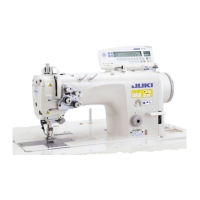– 74 –
1. Thread breakage 1-1) Groove on the bobbin case stopper Grind the groove on the bobbin case stopper.
of the throat plate has scratches.
1-2)
The needle thread tension is too high.
Adjust the needle thread tension.
1-3) Needle-to-hook timing is not 3-A) The clearance provide between the Adjust the clearance provided between the hook and the
properly adjusted. hook and the bobbin case opener. bobbin case opener to 0.2 mm.
3-B)
The clearance provided between the
Adjust the clearance provided between the needle and the
needle and the blade point of the hook.
blade point of the hook to 0.05 mm.
3-C) The clearance provided between Check the clearance provide between the hook and the
the hook and the throat plate. throat plate.
3-D) Lift of the needle bar and the Adjust the lifting amount of the needle bar and the height
needle bar height. of the needle bar properly.
1-4)
Amount of oil in the hook is insufficient.
4-A) Amount of oil in the hook. Properly adjust the amount of oil in the hook.
1-5)
Operating range and pressure of the
5-A) Operating range and pressure of Properly adjust the thread take-up spring.
thread take-up spring are improper. the thread take-up spring.
1-6)
Blade point of the hook has scratches.
Grind the blade point of the hook.
1-7) Periphery of the needle hole in Grind the periphery of the needle hole in the feed plate.
the feed dog has scratches.
1-8) The machine head is not properly
Refer to the Instruction Manual, 11. How to pass the needle thread.
threaded.
1-9) The needle is not properly installed. 9-A) Orientation of the needle. Refer to the Instruction Manual, 8. How to set up the needle.
1-10)
The needle is bent or has a blunt point.
10-A) Needle Replace the needle with a new one.
1-11)
The presser foot is not properly installed. Install the presser foot while facing it in the correct direction.
1-12)The needle thread untwists. 12-A)If thread is likely to break especially when using a tetron thread:
1)
Minimize the needle thread tension and the thread take-up spring pressure as long as stitches are neatly finished.
2) Wind the thread round the needles to reduce the frequency of the trouble.
1-13)Idling stitches are produced.
1-14)A thread loop is not made with Use the thread guide equipped with a felt pad.
consistency when the blade point
of the hook clamps the needle thread.
Trouble Case (1) Case (2) Check and Corrective measures
14. Troubles and corrective measures

